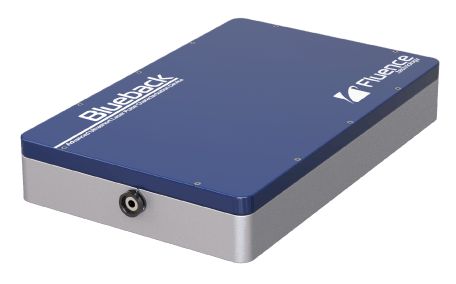light pulses (original) (raw)
Definition: flashes of light
- light pulses
Related: Tutorial on Modeling and Simulation of Fiber Amplifiers and LasersNonlinear Pulse Compression in a FiberCollision of Soliton Pulses in a FiberSoliton Pulses in a Fiber AmplifierParabolic Pulses in a Fiber AmplifierErbium-doped Fiber Amplifier for Rectangular Nanosecond PulsesRaman Scattering in a Fiber Amplifierpulse propertiespulse trainsultrashort pulsesdouble pulsespulse generationpulse characterizationpulse propagation modelingpulsed lasersburst mode lasersultrafast lasersmode-locked lasersQ-switched lasers
Page views in 12 months: 1831
DOI: 10.61835/e9r Cite the article: BibTex BibLaTex plain textHTML Link to this page! LinkedIn
Content quality and neutrality are maintained according to our editorial policy.
📦 For purchasing pulse characterization, use the RP Photonics Buyer's Guide — an expert-curated directory for finding all relevant suppliers, which also offers advanced purchasing assistance.
Contents
Special Properties of Light Pulses
Optical pulses are flashes of light. Particularly very short light pulses are often generated with lasers (laser pulses) and delivered in the form of laser beams, i.e., as a highly directional radiation.
Due to the enormously high optical frequencies, light pulses can be extremely short (ultrashort) when their optical bandwidth spans a significant fraction of the mean frequency. For example, a Gaussian pulse with a center frequency of 300 THz (corresponding to a wavelength of 1 μm) can easily have a bandwidth of 30 THz, and this already corresponds to a pulse duration of ≈ 15 fs if the pulse is transform-limited.
The shortest optical pulses generated directly in lasers (namely, in passively mode-locked titanium–sapphire lasers) have durations around 5 fs, corresponding only to a few optical cycles (few-cycle pulses). Pulse compression techniques applied to similar pulses reach pulse durations of very few femtoseconds, and high harmonic generation even allows the generation of attosecond pulses.
On the other hand, many commercially important laser sources (particularly Q-switched lasers) generate nanosecond pulses (often with considerable pulse energies), which are considered as short but not ultrashort. Nanosecond pulses (from nanosecond lasers) also have many important applications, e.g. in laser material processing.
Depending on the required pulse duration, pulse energy, and pulse repetition rate, different methods of pulse generation, pulse compression and pulse characterization are used, overall covering extremely wide parameter regimes. See the corresponding articles for details, in particular the one on pulse characterization.
High Peak Powers and Intensities
Due to the short pulse durations and the potential for strong focusing, optical pulses can be used for generating extremely high optical intensities even with moderate pulse energies. For example, a 10-fs pulse with only 10 mJ energy has a peak power of the order of 1 TW = 1000 GW, corresponding to the combined power of roughly 1000 large nuclear power stations. This power may be easily focused on spots with a diameter of only a few micrometers. Therefore, amplified ultrashort pulses are very important for high-intensity physics, studying phenomena such as multi-photon ionization, high harmonic generation, or the generation of even shorter pulses with attosecond durations.
Optical Spectrum of Light Pulses
Some light pulses are transform-limited, which means that the optical spectrum is as narrow as possible for the given pulse duration. The transform-limited spectral bandwidth is related to the inverse of the pulse duration. That finite width arises even if the instantaneous optical frequency stays precisely constant during the pulse.
For a single transform-limited pulse, the optical spectrum is continuous (smooth). For periodic sequences of such pulses with a deterministic phase relation between subsequent pulses, as often obtained from mode-locked lasers, the spectrum has the shape of a frequency comb, i.e., it consists of discrete lines which are equidistant. See the article on frequency combs for details.
For not transform-limited pulses, the optical spectrum can be broader, sometimes even far broader. It may then also consist of discrete lines even for a single pulse, but this is then not a frequency comb.
Characterization of Light Pulses
There are various methods for measuring the pulse duration achieved or for pulse characterization in other respects. Particularly for measuring the duration of ultrashort pulses, purely optical techniques are very important, since electronics are too slow for such purposes.
Single Shot or Repetitive Pulse Generation
Short laser pulses in the nanosecond pulse duration regime are often generated either in a single-shot regime (pulse on demand, with long and potentially irregular breaks between the pulses) or in a repetitive mode with a pulse repetition rate which is often in the kilohertz region. In contrast, ultrashort pulses (i.e., with durations in the picosecond or femtosecond region) are often generated as pulse trains with high repetition frequencies of many megahertz or even many gigahertz.
Bursts of Pulses
In some cases, laser sources do not generate a periodic sequence of pulses, but rather a periodic sequence of pulse bursts, where each burst consists of some number of short or ultrashort pulses. Within a burst, one may have a high pulse repetition rate e.g. in the megahertz or gigahertz region, while the repetition rate of the bursts can be much lower, e.g. in the kilohertz region or even less.
For more details, see the article on burst mode lasers.
Pulse Propagation
Pulse propagation in media has many interesting aspects. The peak of a pulse in a transparent medium propagates with the group velocity, not the phase velocity. Dispersion can cause temporal broadening (or sometimes compression) of pulses. For high peak intensities, optical nonlinearities can strongly affect the pulse propagation; often they lead to pulse broadening, but strong nonlinear compression is also possible.
Apart from experimental tests, details of pulse propagation can also be investigated with various kinds of numerical simulation. In some cases, for example for pulse propagation in single-mode fibers or free-space propagation with a fixed Gaussian beam profile, one can neglect the transverse spatial dimensions and consider only the complex amplitude versus time or frequency at each location. More sophisticated numerical models are required for investigating the full spatio–temporal pulse evolution.

Modeling and Simulation of Fiber Amplifiers and Lasers
This is an physics-based introduction into the modeling of fiber amplifiers and fiber lasers, as required for efficient research and development. Many aspects of amplifier and laser operation can be simulated, leading to a solid quantitative understanding.
Frequently Asked Questions
This FAQ section was generated with AI based on the article content and has been reviewed by the article’s author (RP).
What is a light pulse?
A light pulse is a brief flash of light, which is often generated with a laser and delivered in the form of a directional laser beam.
How short can optical pulses be?
Optical pulses can be extremely short, reaching durations in the femtosecond (1 fs = 10−15 s) or even attosecond (1 as = 10−18 s) regime. Some lasers can generate few-cycle pulses lasting for only a few oscillations of the light wave.
Why can ultrashort pulses have extremely high peak powers?
By concentrating a moderate amount of pulse energy into a very short time, an ultrashort pulse can achieve an extremely high peak power. For instance, a 10-mJ pulse with a 10-fs duration has a peak power of about 1 terawatt (1 TW).
What is a transform-limited pulse?
A transform-limited pulse is one for which the optical bandwidth is as narrow as is physically possible for its given pulse duration. The spectral bandwidth is inversely related to the pulse duration.
What does the optical spectrum of a pulse train look like?
A periodic sequence of pulses from a mode-locked laser, where there is a deterministic phase relation between pulses (as one often obtains with lasers), exhibits an optical spectrum in the form of a frequency comb. This means it consists of discrete, equidistant spectral lines.
What happens to a light pulse when it travels through a medium?
When propagating through a medium, the peak of a pulse travels at the group velocity. Effects like dispersion can broaden or compress the pulse, and at high intensities, optical nonlinearities can significantly alter its properties.
Suppliers
Sponsored content: The RP Photonics Buyer's Guide contains 29 suppliers for pulse characterization. Among them:
⚙ hardware
Ultrafast photodetectors from ALPHALAS in combination with high-speed oscilloscopes are the best alternative for measurement of optical waveforms with spectral coverage from 170 to 2600 nm (VUV to IR). For example, photodetectors with rise time 10 ps and bandwidth 30 GHz in combination with 50 GHz sampling oscilloscope can be successfully used to measure optical pulse widths down to 10 ps using deconvolution. Configurations of the photodetectors include free-space, fiber receptacle or SM-fiber-pigtailed options and have compact metal housings for noise immunity. The UV-extended versions of the Si photodiodes are the only commercial products that cover the spectral range from 170 to 1100 nm with a rise time < 50 ps. For maximum flexibility, most models are not internally terminated. A 50 Ohm external termination supports the specified highest speed operation.
⚙ hardware
The Blueback advanced ultrashort laser pulse characterization device is a real-time ultrashort laser pulse characterization device specifically engineered to provide a high-resolution measurement for ultrafast oscillators and amplifiers. It is an essential piece of equipment for everyone who depends on accurate information about properties of their ultrashort pulses. With Fluence Blueback you get more than just a single result. You can watch your pulse evolving in real time.
⚙ hardware
The FSAC benchtop interferometric autocorrelator manufactured by Thorlabs is designed to characterize ultrafast pulse durations from 15 — 1,000 fs in the 650 — 1100 nm range. This autocorrelator for use with femtosecond lasers complements our ultrafast family of lasers, amplifiers, and specialized optics, including nonlinear crystals, chirped mirrors, low GDD mirrors/beamsplitters, and dispersion compensating fiber.
⚙ hardware
Our compact ultrafast autocorrelator is used to characterize ultrafast laser pulses originating from Ti:sapphire and Yb:doped lasers. Featuring a built-in two-photon absorption (TPA) detector, this autocorrelator is ideal for measuring ultrafast femtosecond and picosecond laser pulses at wavelengths from 700 to 1100 nm. The highly sensitive TPA detector allows for measurements of ultrafast laser pulses with high sensitivity by eliminating the need for angle tuning of the SHG nonlinear crystal.
⚙ hardware

Femto Easy offers different kinds of devices for the characterization of ultrashort light pulses:
- Single-shot and scanning autocorrelators are easy tools for measuring pulse durations.
- FROG devices allow for full pulse characterization. They are also available in single-shot and scanning versions.
All devices are optimized for easy installation and handling.
Bibliography
(Suggest additional literature!)
Questions and Comments from Users
Here you can submit questions and comments. As far as they get accepted by the author, they will appear above this paragraph together with the author’s answer. The author will decide on acceptance based on certain criteria. Essentially, the issue must be of sufficiently broad interest.
Please do not enter personal data here. (See also our privacy declaration.) If you wish to receive personal feedback or consultancy from the author, please contact him, e.g. via e-mail.
By submitting the information, you give your consent to the potential publication of your inputs on our website according to our rules. (If you later retract your consent, we will delete those inputs.) As your inputs are first reviewed by the author, they may be published with some delay.
 light pulses
light pulses







